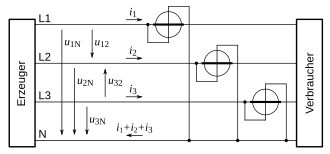Aron circuit
With the Aron circuit , electrical power in the three-phase network can be measured with symmetrical and asymmetrical loads. It is named after the German physicist Hermann Aron , who calculated it in the 1880s. It can only be used in three-wire circuits.
The following description assumes that the voltage and current are sinusoidal and (with reactive power measurement) that the voltage triangle is not distorted. The voltage transformers and current transformers required for high voltage are not shown in the circuit diagrams for the sake of simplicity. For this, reference is made to DIN 43807.
In a three-wire circuit, the total active power can be measured directly with two power meters instead of the usual three. results from the mean value of the instantaneous power with the instantaneous values entered in the image
- .
If the neutral conductor is missing (or if the load is symmetrical)
- ,
and can be converted to two summands
or with the rms values and phase shift angles
To measure reactive power , inductive loads require voltages that lag behind those used for active power measurement by 90 °. To do this, the neutral conductor potential of a star point must be generated with a resistance that is just as large as the resistances of the voltage paths of the power meters. The phase-shifted voltages are a factor lower than in the real power measurement . This must be corrected by means of a voltage transformer with a correspondingly higher secondary voltage or by calculation.
- ,
The explanations in the articles about active power and reactive power for the measuring devices and signed-correct circuits should be observed. Particularly with the Aron connection, unforeseeable results of the individual measured values must be expected.
Individual evidence
- ^ Conrad Matschoss : Men of Technology. A biographical manual . VDI Verlag, Berlin 1925, p. 8f.













![{\ displaystyle Q = {\ sqrt {3}} \ cdot \ left [U _ {\ mathrm {N} 3} \; I_ {1} \ cos \ left ({\ frac {\ pi} {3}} - \ varphi _ {1} \ right) + U_ {1 \ mathrm {N}} \; I_ {3} \ cos \ left ({\ frac {2} {3}} \ pi - \ varphi _ {3} \ right ) \, \ right]}](https://wikimedia.org/api/rest_v1/media/math/render/svg/24560ca542d5b45fa6d7f91d0b0f1ca080fe4c6d)